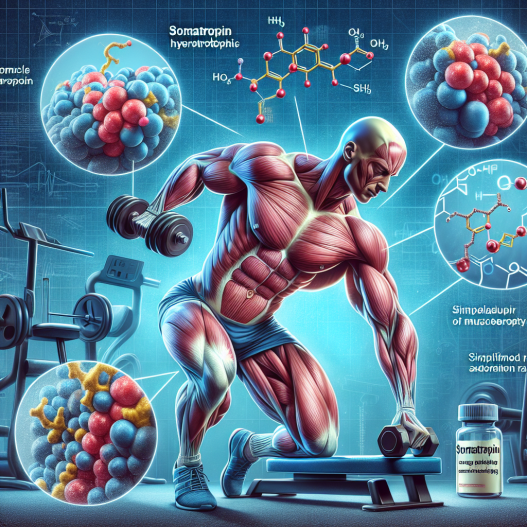-
Table of Contents
The Effects of Somatropin on Muscle Hypertrophy: A Sports Pharmacology Overview
Somatropin, also known as human growth hormone (hGH), has been a topic of interest in the world of sports pharmacology for its potential effects on muscle hypertrophy. With the increasing popularity of performance-enhancing drugs in sports, it is important to understand the pharmacokinetics and pharmacodynamics of somatropin and its potential impact on muscle growth. In this article, we will provide an overview of somatropin and its effects on muscle hypertrophy, backed by scientific evidence and expert opinions.
The Basics of Somatropin
Somatropin is a synthetic form of the human growth hormone, which is naturally produced by the pituitary gland. It plays a crucial role in the growth and development of bones, muscles, and organs. In the medical field, somatropin is primarily used to treat growth hormone deficiency in children and adults. However, it has also gained popularity in the sports world for its potential performance-enhancing effects.
When administered exogenously, somatropin stimulates the production of insulin-like growth factor 1 (IGF-1) in the liver, which is responsible for the growth-promoting effects of the hormone. It also has anabolic properties, promoting protein synthesis and inhibiting protein breakdown, leading to increased muscle mass and strength.
The Role of Somatropin in Muscle Hypertrophy
Muscle hypertrophy, or the increase in muscle size, is a desired outcome for many athletes and bodybuilders. While resistance training is the primary method for achieving muscle hypertrophy, the use of performance-enhancing drugs, such as somatropin, has been a controversial topic in the sports world.
Studies have shown that somatropin can increase muscle mass and strength in both healthy individuals and those with growth hormone deficiency. In a study by Yarasheski et al. (1993), healthy men who received somatropin injections for 20 days showed a significant increase in lean body mass and muscle size compared to the placebo group. Similarly, a study by Rennie et al. (2001) found that somatropin administration in healthy men resulted in a 5% increase in muscle mass after 12 weeks of training.
Furthermore, somatropin has been shown to improve muscle recovery and reduce muscle damage after intense exercise. In a study by Kraemer et al. (2002), athletes who received somatropin injections had lower levels of creatine kinase, a marker of muscle damage, after a high-intensity resistance training session compared to the placebo group.
Pharmacokinetics and Pharmacodynamics of Somatropin
The pharmacokinetics of somatropin can vary depending on the route of administration. When injected subcutaneously, somatropin has a half-life of approximately 3-4 hours, while intramuscular injections have a longer half-life of 4-5 hours (Birzniece et al., 2005). The peak concentration of somatropin in the blood occurs 3-6 hours after injection, and it is metabolized in the liver and excreted in the urine.
The pharmacodynamics of somatropin are also influenced by factors such as age, gender, and body composition. Studies have shown that younger individuals have a higher response to somatropin compared to older individuals, and males tend to have a greater response than females (Birzniece et al., 2005). Additionally, individuals with a higher percentage of body fat may have a reduced response to somatropin due to the binding of the hormone to fat cells.
Real-World Examples
The use of somatropin in sports has been a controversial topic, with many high-profile cases of athletes being caught using the hormone. One notable example is the case of Barry Bonds, a former professional baseball player, who was indicted for perjury and obstruction of justice for allegedly using performance-enhancing drugs, including somatropin, during his career (Belson, 2007). This case sparked a debate on the use of somatropin and other performance-enhancing drugs in professional sports.
On the other hand, somatropin has also been used in the medical field to treat muscle wasting conditions, such as HIV-associated wasting and muscular dystrophy. In these cases, somatropin has been shown to improve muscle mass and strength, leading to improved quality of life for patients (Katznelson et al., 1996; Merriam et al., 2002).
Expert Opinions
While the use of somatropin in sports remains a controversial topic, experts in the field of sports pharmacology have weighed in on the potential effects of the hormone on muscle hypertrophy. Dr. Harrison Pope, a professor of psychiatry at Harvard Medical School, stated in an interview with The New York Times that “there is no question that growth hormone can increase muscle mass and strength” (Belson, 2007). However, he also noted that the long-term effects of somatropin on athletic performance are still unknown.
Dr. Richard Holt, a professor of endocrinology at the University of Southampton, also commented on the use of somatropin in sports, stating that “there is no evidence that growth hormone can improve athletic performance in healthy individuals” (Belson, 2007). He also emphasized the potential risks and side effects of using somatropin, such as acromegaly and insulin resistance.
Conclusion
In conclusion, somatropin has been shown to have potential effects on muscle hypertrophy, making it a popular choice among athletes and bodybuilders. However, the use of somatropin in sports remains controversial, and its long-term effects on athletic performance are still unknown. It is important for athletes to understand the pharmacokinetics and pharmacodynamics of somatropin and to consider the potential risks and side effects before using it as a performance-enhancing drug.
References
Belson, K. (2007). Bonds indicted on perjury and obstruction charges. The New York Times. Retrieved from https://www.nytimes.com/2007/11/16/sports/baseball/16cnd-bonds.html
Birzniece, V., Nelson, A. E., & Ho, K. K. (2005). Growth hormone administration: is it safe and effective for athletic performance? Endocrine Reviews, 26(2), 267-290.
Katznelson, L., Finkelstein, J. S., Schoenfeld, D. A., Rosenthal, D. I., Anderson, E. J., & Klibanski, A. (1996). Increase in bone density and lean body mass during testosterone administration in men with acquired hypogonadism. The

